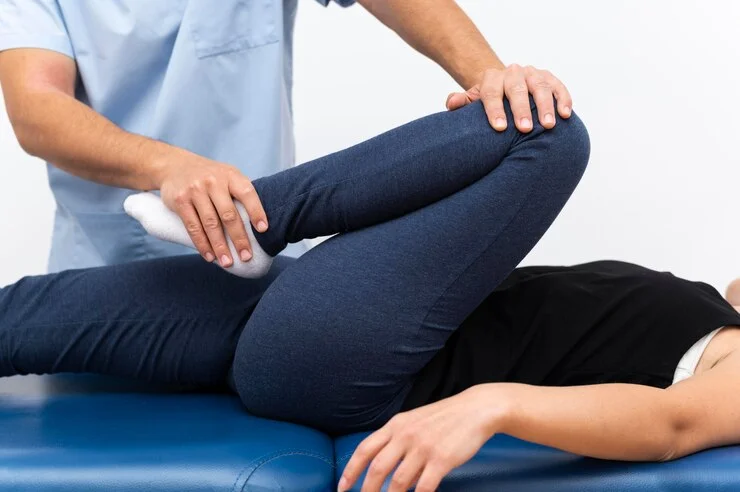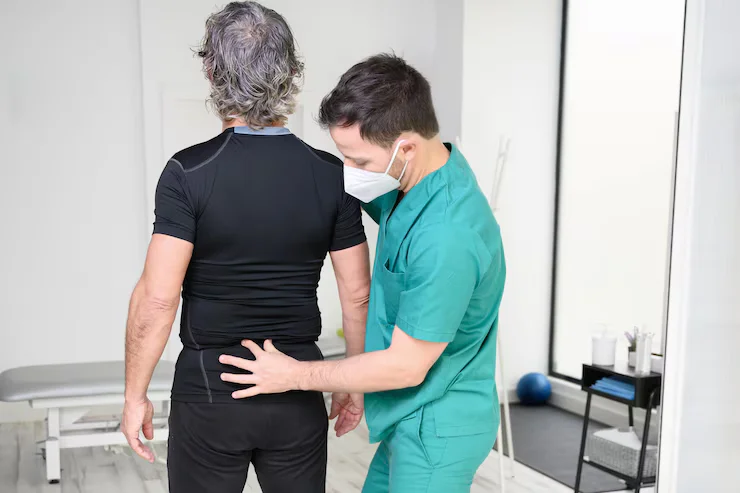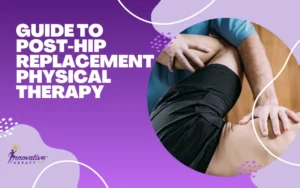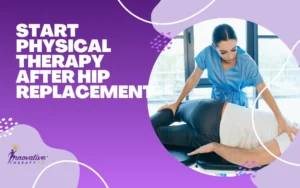Are you embarking on hip replacement physical therapy in Dallas? Dive into the ultimate guide on frontloading – your shortcut to a speedy, effective recovery!
Uncover game-changing techniques, expert tips, and a roadmap to maximize your rehabilitation from day one. Let’s make your hip replacement journey a triumph!
Physical Therapy After Hip Replacement

Embarking on the journey of physical therapy after hip replacement surgery is a meticulous process that begins the moment you awaken in the recovery room.
This phase is not merely a routine; it is a strategic and personalized approach to facilitate your transition from post-surgery to regaining optimal hip functionality.
The Early Stages Of Rehabilitation
The initial focus of physical therapy post-hip replacement is to initiate movement and promote blood circulation without compromising the delicate healing process.
Your dedicated physical therapist will guide you through gentle exercises to prevent stiffness, enhance flexibility, and ensure the initial stages of recovery are smooth.
Gait Training And Walking Mechanics
One of the primary goals of hip replacement physical therapy is to refine your walking mechanics.
Gait training becomes an integral part of the rehabilitation process, focusing on achieving a symmetrical stride, proper weight distribution, and eliminating any compensatory movements.
Range Of Motion Enhancement
Regaining a full range of motion in the hip joint is a gradual but essential aspect of the rehabilitation journey.
Your therapist will employ targeted exercises to enhance flexibility, ensuring that the joint moves freely without causing undue stress.
Guidelines To Protect Your New Hip Joint

The success of your hip replacement surgery depends on following careful guidelines to protect your new joint.
These guidelines cover everything from daily activities to how you sleep, all aimed at making sure your healing process goes smoothly.
Body Mechanics And Movement Precautions
Your physical therapist will carefully teach you about proper body movements to avoid strain on your new hip joint.
Tips like not bending too much at the waist, lifting heavy things carefully, and paying attention to your posture are crucial for keeping your hip replacement in good shape.
Sleep Position Recommendations
Even during moments of rest, the way you position yourself matters. Your therapist may recommend sleeping on your back with a pillow strategically placed between your legs to maintain proper hip alignment.
This not only contributes to restful sleep but also aids in minimizing strain on the healing hip joint.
Regular Monitoring and Adjustments
Hip replacement physical therapy isn’t one-size-fits-all. Your therapist will keep an eye on your progress, tweaking the rehab plan as needed based on how you respond to exercises and your overall recovery path.
Put, physical therapy after hip replacement is a personalized journey.
Each session works toward the goal of not only restoring physical function but also improving your quality of life overall.
Adaptive Equipment After Total Hip Replacement

Using adaptive equipment is a crucial part of post-hip replacement rehab. It aims to improve mobility, foster independence, and reduce the risk of falls.
These carefully chosen aids are invaluable for handling daily challenges while safeguarding the newly replaced hip joint.
Raised Toilet Seat
A raised toilet seat is a simple but essential tool that makes daily activities smoother.
It reduces strain on the hip joint, making sitting and standing more manageable, especially in the early stages of recovery.
Shower Chair
Keeping up with personal hygiene is crucial, and a shower chair becomes a vital tool.
It lets you shower while sitting, lowering the risk of slips and falls and gives a stable platform for bathing without putting stress on the hip replacement.
Grab Bars
Strategically placed grab bars contribute significantly to home safety. These sturdy supports, usually installed in the bathroom and other vital areas, offer stability while standing, sitting, or moving about.
They play a vital role in preventing accidents and providing a sense of security during the rehabilitation period.
Walking Aids
During the initial phases of recovery, walking aids such as crutches, walkers, or canes may be recommended.
These aids help distribute weight away from the healing hip joint, providing support and stability while gradually improving mobility.
Managing Activities of Daily Living Following Surgery
Getting back to daily activities after hip replacement surgery needs careful planning.
Walking with Crutches
Walking with crutches is a fundamental component of early rehabilitation. Your therapist will provide hands-on guidance on the proper technique, emphasizing weight distribution and ensuring a smooth and controlled gait.
This aids in maintaining mobility while minimizing stress on the healing hip.
Crutch Safety
Safety is crucial when using crutches. Ensuring the right crutch height, placing the pads below the armpits correctly, and maintaining a forward-looking posture are vital for safe crutch use.
Regular checks and adjustments will be made to ensure optimal safety throughout the recovery process.
Going Up With Handrail
Ascending stairs with a handrail requires a coordinated effort. Your therapist will provide detailed instructions on the correct foot placement, weight distribution, and utilizing the handrail for support. This phased approach ensures a safe and gradual return to stair-related activities.
Going Up Without Handrail
If there’s no handrail, your therapist will show you how to go upstairs without external support. Take it step by step, lead with the unoperated leg, and maintain a steady pace to reduce strain on the healing hip.
Going Down With Handrail
Descending stairs presents its own set of challenges. Your therapist will instruct you on the proper sequence of movements, utilizing the handrail for support. This careful approach ensures a safe descent, preventing undue stress on the healing hip joint.
Chair Transfer
The seemingly simple act of sitting down and standing up from a chair requires strategic movement to protect the hip joint.
Your therapist will guide you on proper mechanics, emphasizing controlled movements to reduce strain and facilitate a smooth transition.
Using adaptive equipment and managing daily activities strategically are crucial in rehab. This empowers individuals to regain independence while reducing stress on the healing hip joint.
With these adaptive tools and guided techniques, a successful recovery journey is paved.
Best Types Of Exercise After Total Hip Replacement
Picking the right exercises is vital for a successful recovery after total hip replacement. It’s crucial to customize your exercise routine to meet the needs of your healing hip joint. This helps rebuild strength, enhance flexibility, and optimize overall joint function.
Low-Impact Cardiovascular Exercises
Doing low-impact cardiovascular exercises is good for your heart without stressing the hip joint too much. Stationary cycling, swimming, and water aerobics are great options for improving cardiovascular health with minimal impact.
Stationary Cycling
Stationary cycling is a particularly effective exercise for hip replacement recovery. It promotes joint mobility, strengthens the muscles around the hip, and enhances overall cardiovascular fitness. Start with gentle pedalling and gradually increase the intensity as your strength improves.
Aquatic Exercises
Water exercises are great because the water reduces stress on joints. Water aerobics and swimming are excellent for building muscle strength, flexibility, and endurance without putting too much pressure on the hip joint.
Resistance Training
Adding resistance training to your workout helps strengthen the muscles around your hip joint. Start with low-resistance exercises like leg lifts and side leg raises, then gradually increase the challenge as your muscles get stronger.
Stretching and Flexibility Exercises
Stretching exercises play a crucial role in maintaining and improving flexibility. Gentle stretches for the hip, quadriceps, and hamstring muscles help prevent stiffness and promote a full range of motion in the hip joint.
Tai Chi And Yoga
Low-impact activities like Tai Chi and yoga are beneficial for hip replacement recovery. These practices focus on balance, flexibility, and gentle movements, providing holistic benefits for both physical and mental well-being.
Hip Replacement Recovery: Q&A With A Hip Specialist
Navigating the intricacies of hip replacement recovery can be both challenging and enlightening. In this Q&A session, we explore common queries and concerns with a hip specialist, shedding light on the nuances of the recovery process.
When can I Go Home After A Hip Replacement?
The duration of your hospital stay depends on various factors, including the type of hip replacement and your overall health. In most cases, patients can expect to go home within a few days post-surgery once they demonstrate stability, can perform essential activities, and pain is adequately managed.
Will I Need To Use A Walker At First?
It’s normal to use a walker or crutches in the early stages of recovery. Your hip specialist and physical therapist will help you choose the suitable assistive device based on your progress and needs. These aids offer support and stability and help you gradually get back to your regular walking patterns.
When Will My Hip Incision Heal?
The healing timeline for the hip incision typically spans several weeks. Your surgeon will provide specific instructions on wound care, and your therapist will guide you on movements to avoid during this critical healing period.
How Soon Does Rehabilitation Therapy Start After The Hip Surgery?
Rehabilitation therapy typically starts one or two days after surgery. Getting started early is essential for a smooth recovery. Your therapist will create a personalized program to slowly build up strength, flexibility, and function in your hip joint.
What Is Considered A Normal Amount Of Pain After A Hip Replacement Surgery?
Understanding and managing pain is a crucial aspect of the post-hip replacement journey.
The perception of pain varies among individuals, and what might be considered normal for one person may differ for another.
However, specific general guidelines can help establish expectations for the level of pain after hip replacement surgery.
Immediate Postoperative Period
Right after surgery, it’s normal to feel some pain, and the healthcare team usually provides medications to manage it well. Pain is different for everyone, and patients might use words like soreness, discomfort, or aching to describe how they feel around the surgical site.
Gradual Reduction
As the initial healing progresses, most individuals can expect a gradual reduction in pain. Pain management strategies, including medications, physical therapy, and appropriate rest, contribute to alleviating discomfort. It’s common for the intensity of pain to be at its highest in the first few days post-surgery and then gradually diminish over subsequent weeks.
Individual Variations
Understanding that everyone experiences pain differently is crucial. Factors like pain tolerance, existing health conditions, and overall health can affect how you feel pain. Talking openly with your healthcare team about your pain is essential. This helps them make the proper adjustments to your pain management plan based on your individual needs.
Pain during Rehabilitation
Being active in physical therapy and rehab exercises is vital for hip replacement recovery. It’s normal to feel some discomfort during these activities, but it shouldn’t be overwhelming. If pain is making it hard for you to take part in rehab, let your healthcare team know right away so they can check and help you out.
When to Seek Help
Some pain is normal during recovery, but sure signs may mean you need to see a doctor right away. If the pain doesn’t go away or gets worse, if there’s sudden swelling, changes in skin colour around the surgery area, or signs of infection, make sure to tell your healthcare provider promptly.
How Soon Can I Return To Regular Activities After A Hip Replacement?
Getting back to regular activities after hip replacement varies for each person. It depends on things like your overall health, how well you follow your rehab plan, and the kind of daily activities you do.
There’s no one-size-fits-all answer, but having a general idea can help you understand the expected timeline.
Immediate Postoperative Period
In the immediate postoperative period, the focus is on pain management, mobility, and initiating gentle exercises. Most individuals can expect to return home within a few days to a week after surgery, but the resumption of regular activities is a gradual process.
Six Weeks
At about six weeks, many people feel much better and can start walking without help. You can do light activities, but there might still be limits on more challenging or high-impact exercises.
Three to Six Months
From three to six months post-surgery, many patients start doing light activities like driving and might even return to work, depending on their job. It’s crucial to keep following the rehab plans and slowly bring back activities during this phase for a smoother recovery.
Beyond Six Months
After six months, you can gradually start more intense activities, including higher-impact exercises, with your healthcare team’s guidance. Full recovery and getting back to all your regular activities may take more time beyond this period. Listen to your healthcare professionals at the right pace.
Individual Variations
Getting back to your regular activities after hip replacement varies for each person. Your overall health, how well you follow rehab instructions, and any unexpected issues can affect how quickly you recover. Talking openly with your healthcare team ensures a personalized approach that matches your progress.
What Could Slow Down My Recovery?
Several factors can slow down the recovery process after hip replacement surgery.
Being aware of these factors and actively addressing them can contribute to a smoother and more efficient recovery.
Lack Of Adherence To Rehabilitation Plans
Consistent participation in prescribed rehabilitation exercises is critical for a successful recovery. Lack of adherence to these plans, whether due to fatigue, discomfort, or other reasons, can impede progress. Engaging fully in physical therapy is essential for rebuilding strength, flexibility, and overall joint function.
Complications During Recovery
Unexpected problems like infections, blood clots, or issues with the implant can make recovery slower. It’s important to talk to your healthcare team right away if you notice any new problems. Promptly addressing concerns helps prevent complications from getting in the way of your progress.
Poor Pain Management
Good pain management is crucial for a smooth recovery. If pain isn’t well controlled, it can make it hard to do rehab exercises and increase discomfort. Talking openly with your healthcare providers about your pain ensures they can make the proper adjustments to manage it better.
Insufficient Rest And Overexertion
Balancing activity with adequate rest is vital for recovery. Overexertion or pushing too hard during the early stages can lead to fatigue and potentially slow down the healing process. Following activity guidelines and allowing the body to rest and recover is essential.
Pre-existing Health Conditions
If you have health issues like diabetes or heart problems, they can affect how quickly you recover. Dealing with these conditions and working with your healthcare team to manage them well helps make your rehab smoother.
Psychological Factors
Mental well-being plays a significant role in recovery. Anxiety, stress, or depression can impact motivation and engagement in rehabilitation. Addressing psychological factors through support, counselling, or other interventions is crucial for promoting a positive mindset and progress.
Poor Nutrition and Hydration
A balanced diet and adequate hydration are essential for healing and recovery. Poor nutrition can contribute to weakness and delayed healing. Ensuring that the body receives the necessary nutrients supports overall well-being and accelerates the recovery process.
How Long Will My Hip Replacement Implant Last?
The longevity of a hip replacement implant depends on various factors, including the type of implant, the patient’s activity level, overall health, and adherence to postoperative care.
While modern implants are designed to be durable, they are not indestructible.
Average Lifespan
On average, hip replacement implants are expected to last between 15 to 20 years. However, many implants continue to function effectively for even more extended periods. Advances in implant technology and surgical techniques have contributed to improved longevity and durability.
Factors Affecting Implant Longevity
Patient Activity Level
High-impact activities and excessive stress on the hip joint can accelerate wear and tear on the implant. Patients who engage in intense physical activities or sports may experience a shorter lifespan of the implant compared to those with a more sedentary lifestyle.
Implant Material And Design
The materials used in the implant, such as metal, ceramic, or polyethene components, can impact its longevity. Advances in materials and design have led to more wear-resistant implants, contributing to extended durability.
Surgical Technique
The precision and technique used during the surgical procedure also play a role in the implant’s lifespan. Accurate placement, proper alignment, and thorough rehabilitation contribute to the overall success of the hip replacement.
Patient Health
The patient’s overall health, including factors like weight, bone density, and general health conditions, can affect how well the implant integrates with the surrounding bone and tissues. These factors play a role in the success of the hip replacement surgery and the long-term outcome.
Monitoring And Follow-up
Regular follow-up appointments with the healthcare team are essential to monitor the condition of the implant over time. X-rays and other imaging studies may be conducted to assess any signs of wear, loosening, or other issues. If concerns arise, interventions such as revision surgery may be considered.
How long After Replacing One Hip Should I Wait To Return The Other?
I am deciding when to replace the second hip after the first hip replacement, which is a personalized decision. It depends on the patient’s condition, symptoms, and overall health. There’s no set timeline, and the choice is made together by the patient and the healthcare team, considering individual needs and circumstances.
Symptomatic Considerations
Deciding to replace the second hip is often based on symptoms and functional limitations. If there’s a decline in the quality of life due to pain, reduced mobility, or other issues in the second hip, the healthcare team may consider the option of replacement. It’s about improving life quality and addressing specific issues.
Interval between Surgeries
The time between replacing one hip and the other can vary. Some people go for bilateral hip replacement, addressing both hips relatively close in time. Others prefer a staggered approach, giving time for recovery and rehabilitation between surgeries. It depends on what works best for each individual.
Individualized Assessment
The decision for the timing of the second hip replacement is based on an individualized assessment. Factors such as the patient’s overall health, recovery from the first surgery, and preferences play a significant role. The healthcare team considers the unique circumstances of each patient to determine the most suitable approach.
Rehabilitation And Recovery
The recovery period after the first hip replacement is a crucial factor in deciding when to proceed with the second surgery. Adequate rehabilitation and ensuring that the patient has regained sufficient strength and mobility are vital considerations before planning the replacement of the double hip.
Advanced Exercises And Activities
As you regain strength during recovery, advanced exercises can be introduced with guidance from your healthcare team. These exercises aim to boost strength, flexibility, and overall joint function.
Strength Training
Take your strength training up a notch with advanced exercises using resistance bands or weights. These activities focus on specific hip muscles, enhancing stability and function.
Functional Movements
Adding functional movements to your workout mimics real-life activities. Try lunges, squats, and step-ups, gradually ramping up the difficulty as you go. This helps improve overall strength and mobility.
Cardiovascular Conditioning
Boost your endurance and heart health with advanced cardiovascular exercises like brisk walking, cycling, or elliptical training. These activities add a well-rounded touch to your fitness routine.
Low-Impact Sports And Activities
If you love sports and fun activities, go for low-impact options like swimming, golf, or cycling. Doing things you enjoy not only keeps you active but also makes your lifestyle more exciting and satisfying.
Consultation With Healthcare Team
Always check with your healthcare team before moving on to more challenging exercises. They’ll evaluate your progress, recommend suitable activities, and make sure the exercises match your rehab goals and joint preservation. This ensures a safe and effective path towards recovery.
FAQ More About Hip Replacement Physical Therapy
How Long Should You Do Physical Therapy After Hip Replacement?
Physical therapy duration varies, but most individuals benefit from several weeks to a few months of consistent rehabilitation. Your therapist will assess your progress and adjust the plan accordingly.
What Is the Best Exercise After a Total Hip Replacement?
Low-impact exercises such as swimming, stationary cycling, and walking are excellent choices for post-hip replacement. Your therapist will tailor the exercise program to your specific needs.
What Three Things Should Be Avoided After Hip Replacement Surgery?
Avoid excessive bending at the waist, crossing your legs, and sitting on low surfaces. These precautions protect your new hip joint from unnecessary stress.
How Long Does It Take for Muscles to Strengthen After Hip Replacement?
Muscle strengthening occurs gradually, and the timeline varies among individuals. Consistent engagement in prescribed exercises accelerates the strengthening process.
How Long Does It Take for Muscles to Stop Hurting After Hip Replacement?
Muscle soreness is normal, especially in the early stages of rehabilitation. As your muscles adapt and strengthen, the discomfort should diminish over time.
What Role Does Physical Therapy Play in the Recovery Process After Hip Surgery?
Physical therapy following hip surgery, particularly in the form of hip replacement physical therapy, is crucial for promoting proper healing, restoring mobility, and ensuring a successful recovery.
How Soon Can I Begin Hip Replacement Physical Therapy After Surgery?
Patients can typically start hip replacement physical therapy soon after surgery, often within a day or two, to initiate rehabilitation and support optimal recovery.
What Specific Exercises Are Included in Hip Replacement Physical Therapy?
Hip replacement physical therapy typically involves a series of exercises aimed at improving range of motion, strengthening hip muscles, enhancing balance, and promoting functional mobility.
How Long Does Hip Replacement Physical Therapy Usually Last?
The duration of hip replacement physical therapy varies depending on individual factors, but it often continues for several weeks to months to achieve the best outcomes.
Can Hip Replacement Physical Therapy Help Reduce Pain and Improve Mobility?
Yes, hip replacement physical therapy is designed to reduce pain, improve range of motion, strengthen muscles, and enhance mobility in the hip joint.
What Are The Benefits Of Participating In Hip Replacement Physical Therapy?
Participating in hip replacement physical therapy can lead to reduced pain, improved function, increased independence, and a faster return to daily activities and hobbies.
Is Hip Replacement Physical Therapy Necessary for All Patients After Surgery?
While the need for hip replacement physical therapy may vary depending on individual factors, it is generally recommended for most patients to optimize their recovery and long-term outcomes.
How Can I Find a Qualified Physical Therapist for Hip Replacement Physical Therapy?
You can find a qualified physical therapist experienced in hip replacement physical therapy through recommendations from your surgeon, referrals from your primary care physician, or by researching physical therapy clinics in your area specializing in orthopaedic rehabilitation.
Conclusion
In conclusion, hip replacement physical therapy is a vital component of post-surgery rehabilitation, facilitating a swift return to mobility and improved quality of life. By partnering with experienced professionals and adhering to personalized treatment plans, individuals can overcome challenges and embrace an active lifestyle once again. With a focus on holistic care and ongoing support, the journey to recovery becomes more manageable and fulfilling.





